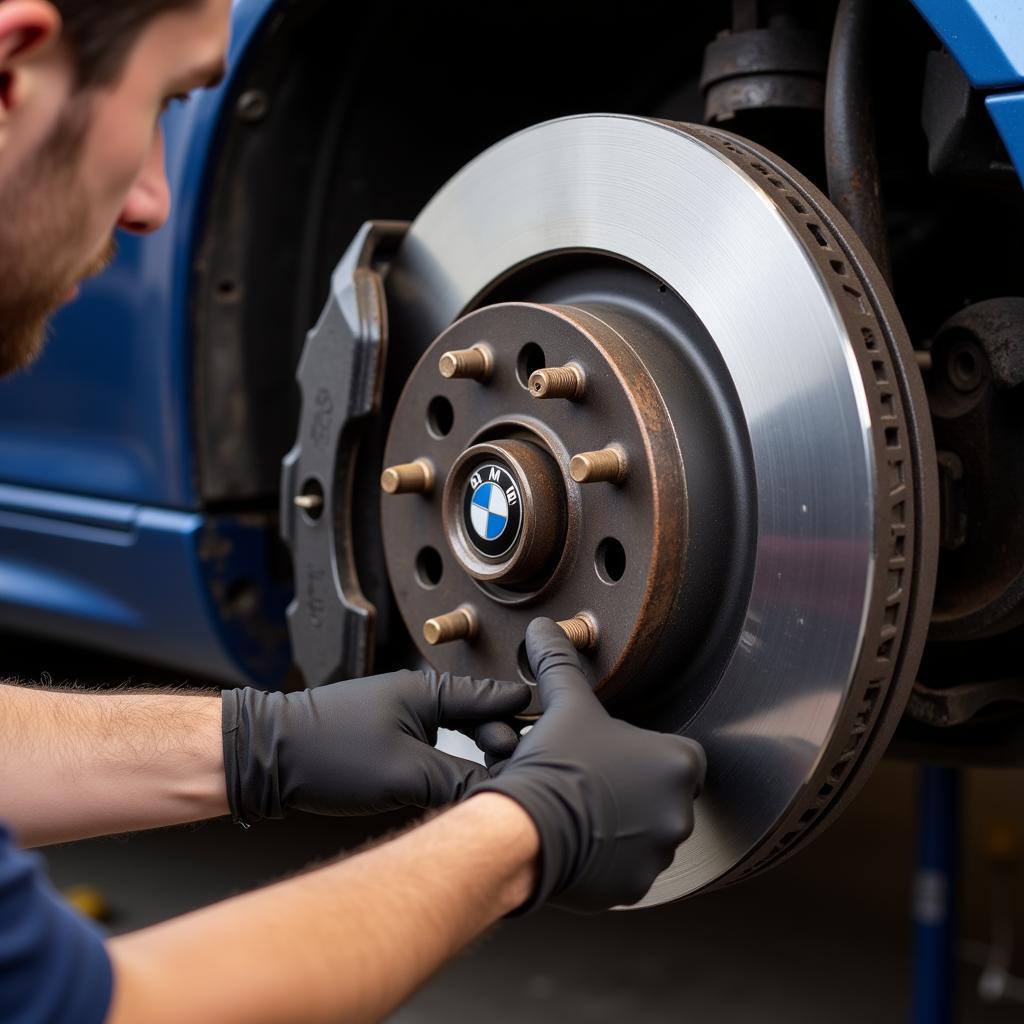The dreaded brake pad warning light on your BMW 320d E46 can be a source of anxiety. Understanding why this light illuminates and how to address the issue is crucial for maintaining your vehicle’s safety and performance. This comprehensive guide will explore the common causes of the BMW 320d e46 brake pad warning light, providing you with the knowledge and steps to effectively troubleshoot and resolve the problem.
Understanding the Brake Pad Warning Light
The brake pad warning light is part of your BMW’s braking system monitoring. It’s designed to alert you when your brake pads are worn down to a point where they need replacing. Ignoring this light can lead to further damage, compromised braking performance, and potentially dangerous driving situations.
This early warning system is triggered by a sensor embedded within the brake pad material. As the pad wears down, this sensor eventually comes into contact with the brake rotor, completing a circuit and illuminating the warning light on your dashboard.
While worn brake pads are the most common culprit, other factors can trigger the warning light.
After this initial paragraph, I’d like to link to an article about preventative maintenance: flash brake early to warn the tailgater
Diagnosing the Issue: Beyond Worn Brake Pads
While worn brake pads are the typical reason for the warning light, other issues can be at play. These include:
- Faulty Brake Pad Wear Sensor: Sometimes the sensor itself can malfunction, triggering the warning light prematurely.
- Low Brake Fluid: Low brake fluid can also activate the warning light, indicating a potential leak or other issue within the braking system.
- Worn Brake Rotors: While less common, excessively worn brake rotors can also contribute to the warning light illuminating.
- Wiring Problems: Damaged or corroded wiring in the braking system can cause intermittent or constant illumination of the warning light.
Troubleshooting the BMW 320d E46 Brake Pad Warning Light
Here’s a step-by-step guide to help you diagnose and address the brake pad warning light on your BMW 320d E46:
-
Check the Brake Pads: Visually inspect the brake pads through the wheel spokes. If the pad material is thin or you can see the metal backing plate, it’s time for replacements.
-
Inspect the Brake Pad Wear Sensor: Examine the sensor for any signs of damage or dislodgement.
-
Check the Brake Fluid Level: Locate the brake fluid reservoir and ensure the fluid level is within the recommended range.
-
Inspect Brake Lines and Hoses: Look for any leaks or signs of damage along the brake lines and hoses.
-
Consult a Professional: If you’re unable to identify the cause or are uncomfortable working on your brakes, consult a qualified BMW technician or mechanic. They have the expertise and specialized tools to diagnose and repair complex brake system issues.
 BMW 320d E46 Brake Pad Inspection
BMW 320d E46 Brake Pad Inspection
Replacing Brake Pads and Sensors
If your brake pads are worn, it’s crucial to replace them promptly. This typically involves removing the caliper, installing new pads and sensors, and then reassembling the braking system.
“Always replace brake pads in axle pairs,” advises Michael Schmidt, Master Automotive Technician. “This ensures even braking performance and prevents uneven wear on the rotors.”
Why Regular Brake Maintenance is Essential
Regular brake maintenance is essential for optimal vehicle safety and performance. This includes routine inspections, fluid changes, and timely replacement of worn components.
“Preventive maintenance is always more cost-effective than dealing with major repairs down the line,” states Anna Kowalski, Certified BMW Specialist. “Regular brake checks can identify potential problems early on, preventing costly repairs and ensuring your safety on the road.”
Conclusion
The brake pad warning light on your BMW 320d E46 is a crucial safety feature. Understanding its causes and taking appropriate action ensures optimal braking performance and prevents potential hazards. Regular maintenance and timely repairs will keep your BMW 320d E46 stopping safely and reliably for years to come. Don’t ignore the warning light – address the issue promptly.
FAQ
-
How often should I check my brake pads? It’s recommended to visually inspect your brake pads every 10,000 miles or during routine maintenance.
-
Can I drive with the brake pad warning light on? While you might be able to drive a short distance, it’s highly discouraged. Continuing to drive with worn brake pads can damage the rotors and compromise braking performance, leading to dangerous driving conditions.
-
How much does it cost to replace brake pads on a BMW 320d E46? The cost varies depending on the type of brake pads and labor rates in your area.
-
What are the symptoms of worn brake pads? Symptoms include squealing or grinding noises, a pulsating brake pedal, and increased stopping distance.
-
Can I replace brake pads myself? While possible, replacing brake pads requires some mechanical skill and specialized tools. If you’re unsure, it’s best to consult a qualified mechanic.
-
What is the difference between brake pads and brake rotors? Brake pads are the friction material that clamps down on the brake rotors to stop the vehicle. Rotors are the metal discs that the brake pads grip.
-
How can I prevent premature brake pad wear? Avoid aggressive driving habits, such as hard braking and rapid acceleration. Coasting to a stop whenever possible can also help extend the life of your brake pads.

